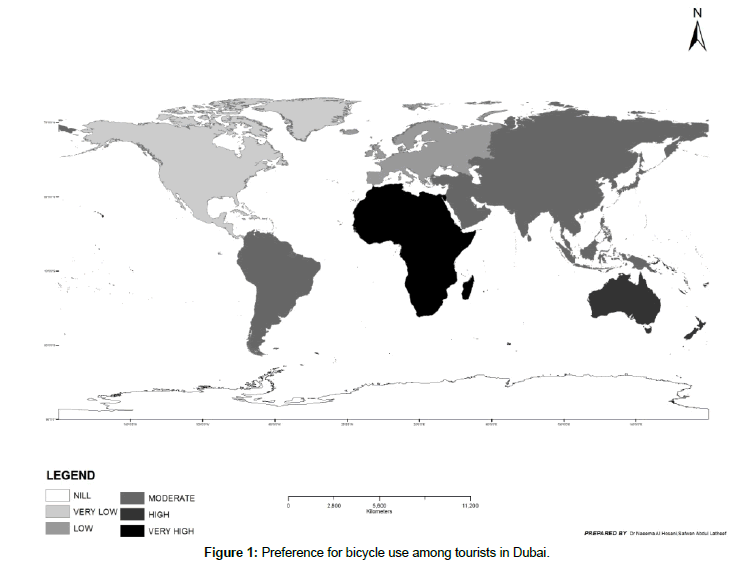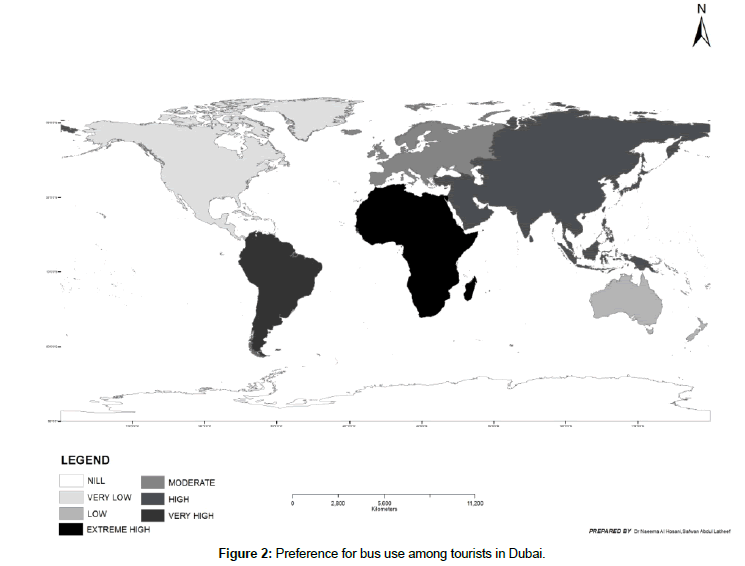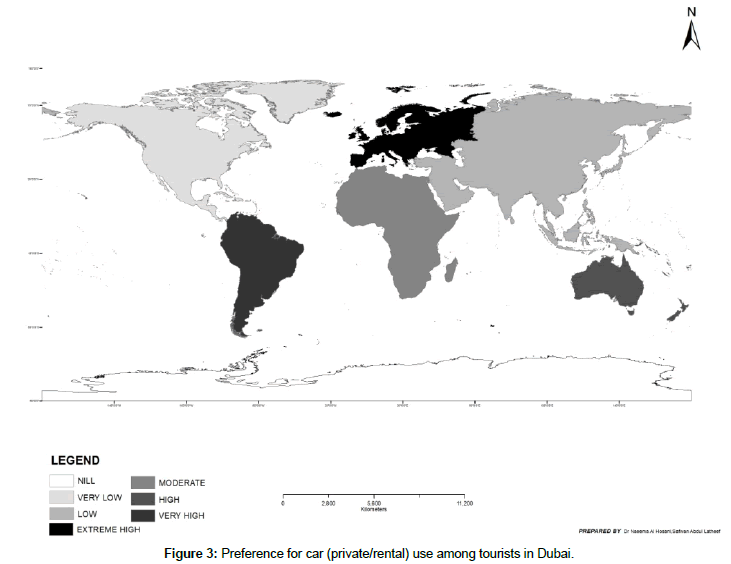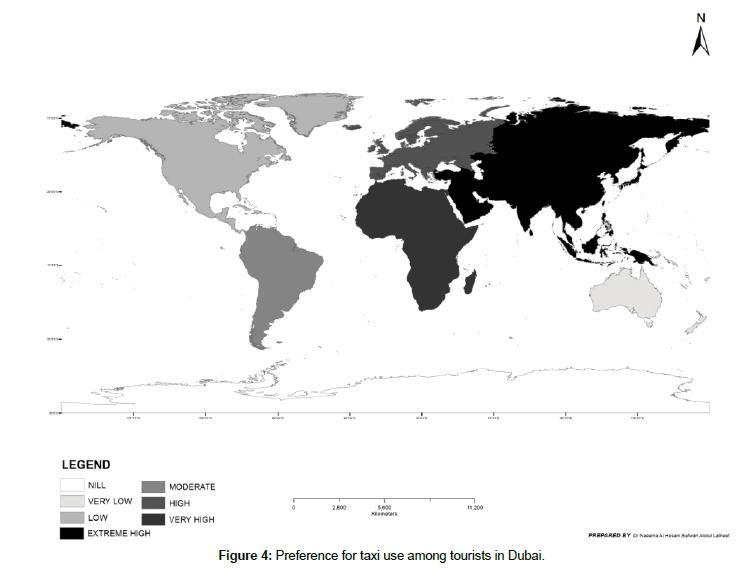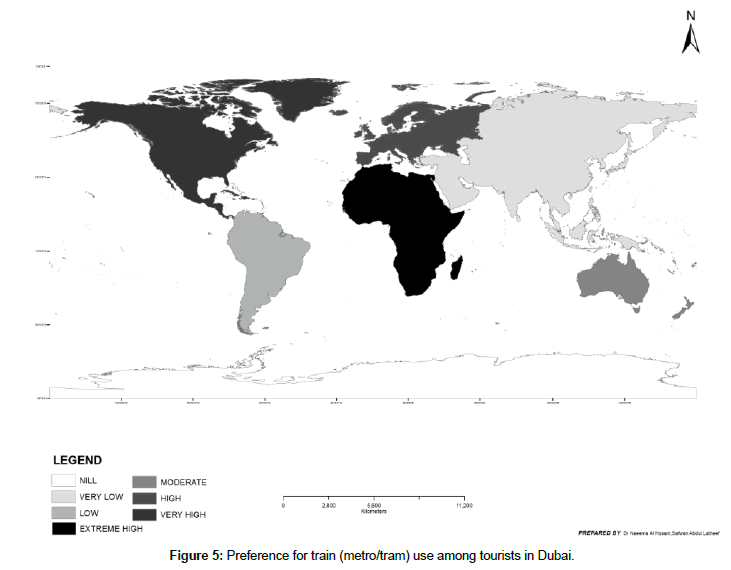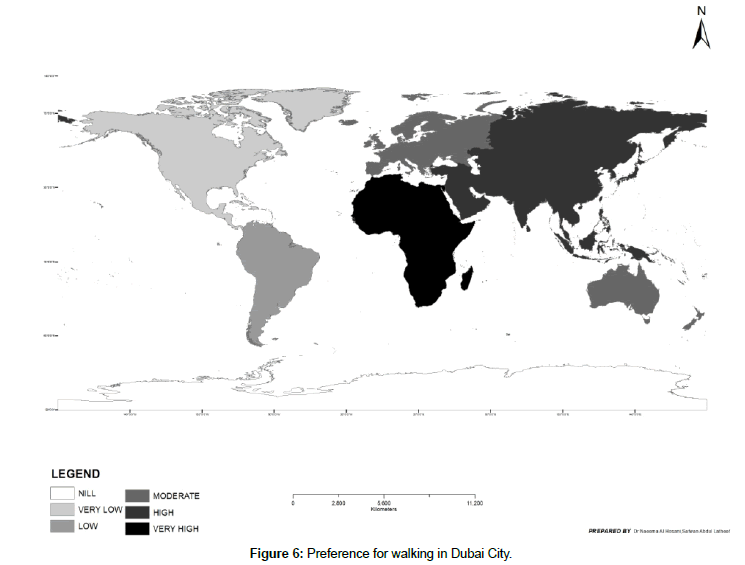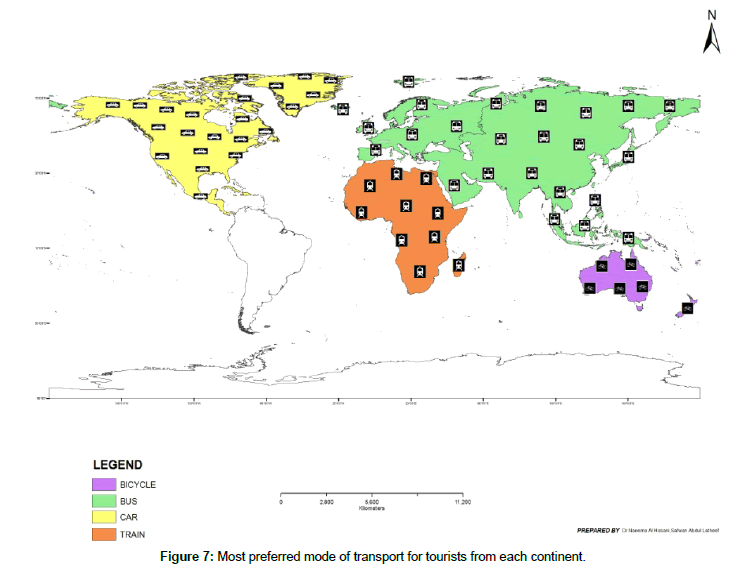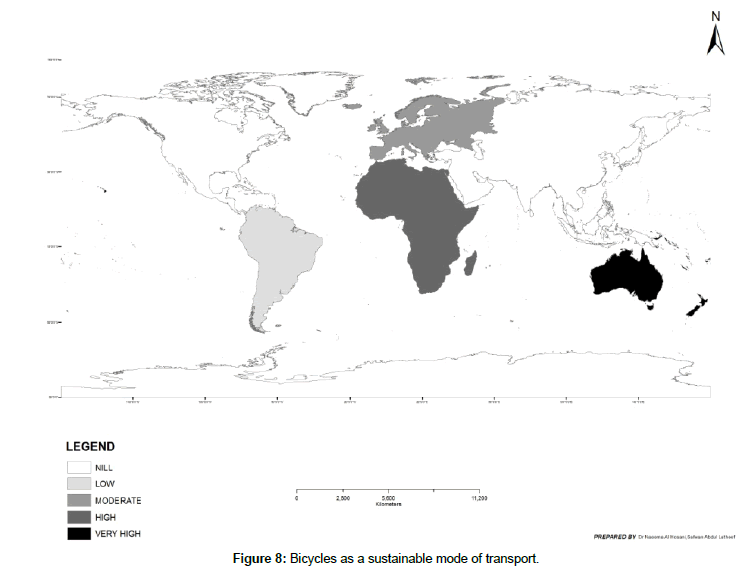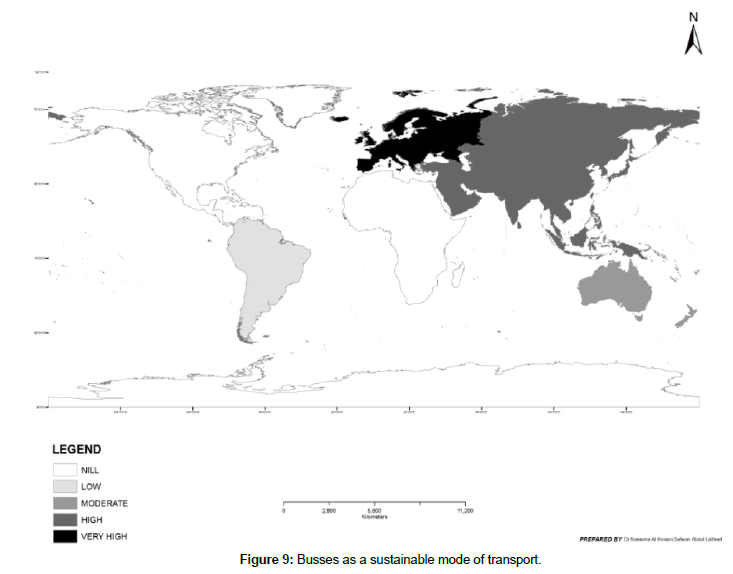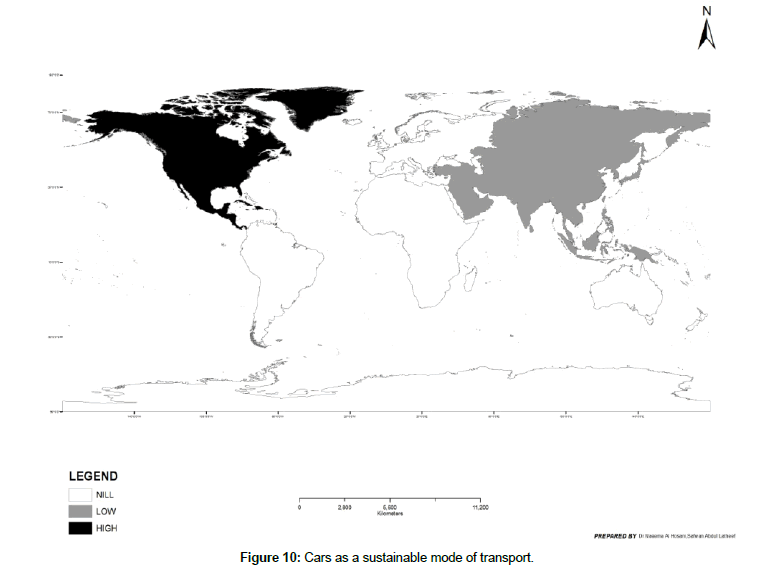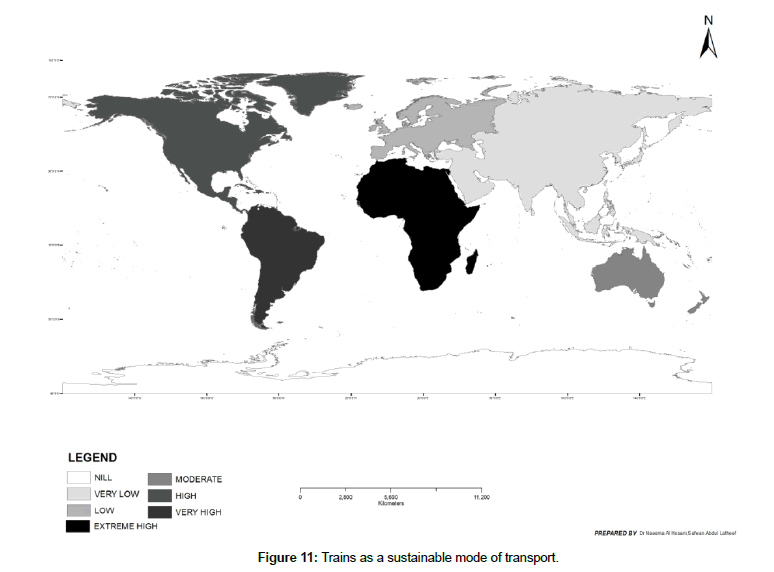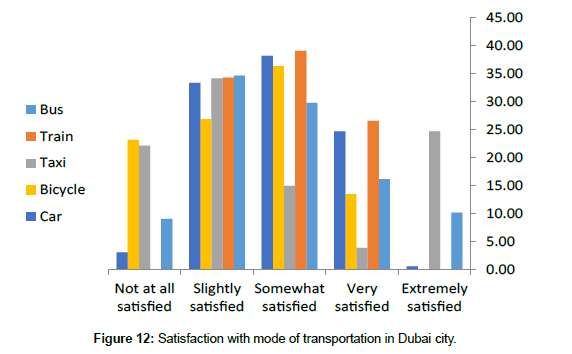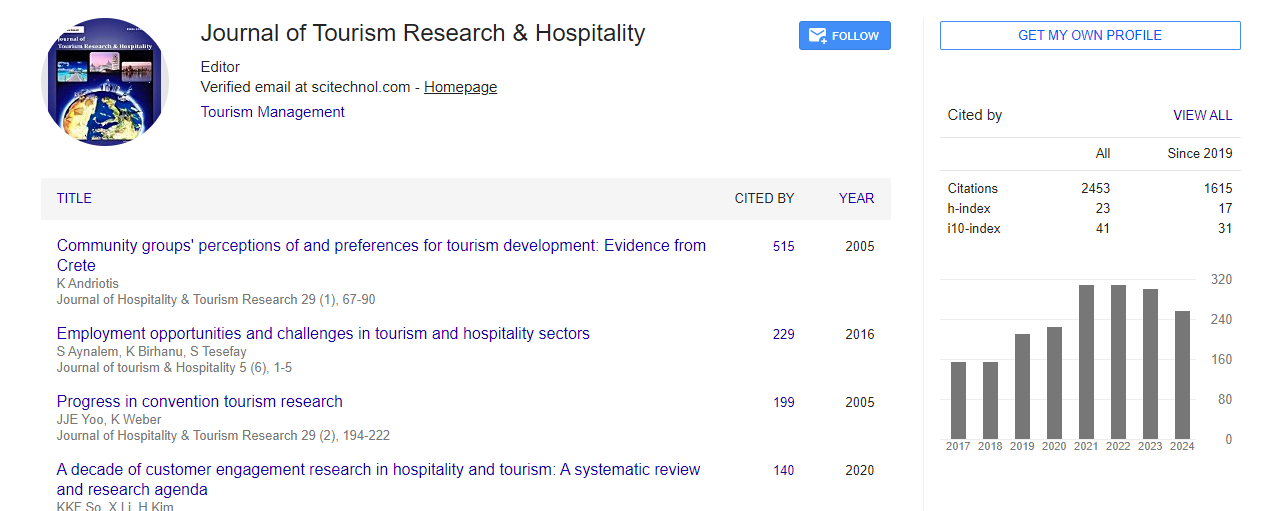Research Article, J Tourism Res Hospitality Vol: 7 Issue: 2
Sustainable City Transport Strategies: Tourist Perspectives on Dubai
Naeema Al Hosani and Abul Salam*
Department of Geography and Urban Planning, CHSS UAE University, Al Ain Abu Dhabi, 15551, UAE
*Corresponding Author : Abul Salam
UAE University, Geography and Urban Planning Department, CHSS, 15551, Al Ain, UAE
Tel: 00971508804043
E-mail: abulsalam@uaeu.ac.ae
Received: February 03, 2018 Accepted: March 09, 2018 Published: March 15, 2018
Citation: Hosani NA, Salam A (2018) Sustainable City Transport Strategies: Tourist Perspectives on Dubai. J Tourism Res Hospitality 7:2. doi: 10.4172/2324-8807.1000184
Abstract
In any tourist destination, a functioning transport infrastructure and system is vital. Transportation systems provide tourists the means for moving within and among cities. For the Emirate of Dubai to continue to be a major hub of tourism and business while still maintaining a healthy living environment for its residents, direction towards sustainable transport network and facilities is inevitable. In Dubai, transportation experts, city planners, and tourism bodies often seek the most sustainable modes of transportation for tourists and sustainable-development transport strategies. One key component missing from information in such endeavors is the opinions and thoughts of tourists themselves on sustainable transport in the study area. The primary objectives of this study was to investigate the views and opinions of the visiting tourists in their usage of different transport modes, as well as the distances they travel within the city and their views on the best strategies of sustainable transport for the city of Dubai to pursue. A systematic random sampling approach was used to collect information from 1000 tourists using self-administered questionnaires with closed and open-ended questions. The results revealed diverse opinions that varied widely across their geographic region of origin: bicycle was a preferred mode of transport for people coming from Africa, Asia, and Australia, while bus usage rated high for people from Africa, Asia, and South America, and Europeans preferred private or rental cars. Tourists’ opinions regarding adoption of sustainable transport showed that the majority, 60.1%, preferred different transport modes for sustainable development, while 23.4% preferred vehicle/technological changes. It is interesting to note that respondents with higher levels of education ranked buses/trains as the most sustainable mode of transport for Dubai, while respondents with high school and Bachelor’s degrees believed that taxis were the most optimum.
Keywords: Dubai; Transport; Tourism; Sustainable transport; Survey
Introduction
Dubai is one of seven emirates in the United Arab Emirates, in the southeast of the Arabian Peninsula on the Arabian Gulf. It borders Oman to the east and Saudi Arabia to the south [1]. Dubai has emerged as a major tourist destination because its safety and infrastructure have attracted business developers and consumers. Dubai will contribute in very diverse ways to the non-oil sectors of the country’s gross domestic product (GDP) by the year 2030; therefore, it is widely recognized as one of the world’s leading international tourism destinations. Forty years ago, Dubai’s rate of development was slow as compared to rest of the world; nowadays, its landscape includes new luxury residences, large shopping centers and malls, imaginative man-made islands (e.g. the palm tree islands, a map of the world), luxurious hotels (e.g. the seven-star Burj Al Arab hotel), creative theme parks, international events, and festivals [2]. The number of tourist arrivals in Dubai has been increasing and reached 10.4 million visitors in 2014, recording a large growth rate compared to the previous year [3]. Dubai’s government, as part of its “tourism vision 2020,” seeks to welcome 20 million tourists per year by 2020, and its goal is to triple tourism’s contribution to the emirate’s economy [4]. Therefore, servicing the huge inflow of tourists requires an efficient transport system to and in the city.
Tourism is one of the fastest-growing economic activities in many countries and has numerous economic and social benefits on the communities offering employment, business opportunities, and economic diversification [5-8]. A fundamental part of a successful tourism industry is the availability of a functioning transportation system. Transportation is part of the tourism system that attracts tourists to their destinations, getting them around and taking them away once their trips are over. As such, transportation is one of the major foundations for a vibrant tourism industry; furthermore, it is a key element in the improvement of tourism facilities’ spatial distribution.
The issue of transportation networks and environmental impact is two sided. On one hand, transportation networks provide excellent opportunities for socioeconomic benefit through the movement of people, goods, and freight; on the other hand, corresponding environmental degradations are classified as major sources of air and land pollution.
The impacts of transport networks can be classified into three types, according to Rodrigue [9]. First, the direct impact, that is the immediate consequences, of transport activities are felt by the environment, where the cause and effect relationship is generally clear and well understood. The secondary, indirect impact of transport activities is on environmental systems. They are often of higher consequence than direct impacts, but the involved relationships are often misunderstood and difficult to establish. The third are the cumulative impacts related to the additive, multiplicative, or synergetic consequences of transport activities. These account for the varied effects of direct and indirect impacts on an ecosystem, which are often unpredictable.
For the emirate of Dubai to continue to be a major hub of tourism and business while still maintaining a healthy living environment for its residents, the direction towards sustainable transport network and facilities is inevitable. In the past few decades, the government of Dubai has realized the need to address transportation’s impact and has been actively considering the implementation of sustainable transportation practices. Transportation experts, city planners, and tourism bodies are continuously seeking the most sustainable modes of transportation for tourists and the best transport strategies for sustainable development.
One key missing component of information in such endeavors is the opinions and thoughts of the tourists themselves on sustainable transport in the Emirate of Dubai. The development of a comprehensive and functioning sustainable transportation policy and system is usually the role of many bodies within the government and public. However, tourists are among the major users of the transport facilities within the emirate, and hence their opinions and input are vital for developing such comprehensive strategies.
The primary objective of this study is to investigate the views and opinions of the visiting tourists on their usage of the different transport modes in Dubai, the distances they travel within the city, their opinions of the most sustainable transport mode that they would like to see more of, and their views on the best strategies of sustainable transport the emirate should pursue. The findings would serve as integral input to development of sustainable transport strategies. Knowing what modes of transportation that tourists use at an urban destination is justified by several arguments. First, transport infrastructure has a key role in destination development [9-12]. Second, transport is a significant element of tourism systems and a topic in tourism research [13]. However, transport has not been well examined in the context of tourist destination [12,14,15]. Third and furthermore, an added value of such research is a move towards sustainable tourism, in which tourists visit a place and make a positive impact on the environment, society, and economy. This will not be possible without the development of sustainable transportation systems. Therefore, sustainable transport is essential for sustainable tourism [16].
Mode of transport is one of the major factors in sustainable urban tourism. Therefore, it is important to understand how tourists use the different modes of transport so that policies and marketing strategies for a modal shift can be developed. In addition, Dubai as a major tourism city in the United Arab Emirates has a diversity of transport network systems that provide excellent context for a study of tourist use of modes of transport at an urban destination.
Modes of transportation in Dubai
The rapid growth in the physical and economic sectors of Dubai has raised important challenges to the city’s transportation system; Dubai, especially, uses a variety of modes of transport and has spent billions of dollars on building a modern city that aligns with the development of the world [17]. Chaudhry [18] stated that the total number of cars in Dubai in 2012 was 1,021,880 and that by 2020 the number of private cars is expected to be 1.5 million. In addition, public transport is used for only 6% of total trips made in Dubai, compared to 65% in Singapore and 22% in Toronto, Canada [18]. Moreover, Dubai’s government in 1997 made a strategic decision to develop a high-quality metro system in order to solve challenge of the transport system, as well as to support Dubai’s motivation to become a Middle East financial hub and world transit center. By 2006, Dubai’s Road and Transport Authority (RTA) officially launched the Dubai Metro as a systematic strategic aim to increase the use of public transportation from less than 6% of all transport (in 2006) to about 14% in 2014, and is still seeking to reach a goal of 30% by 2030 [19]. Moreover, other modes of transportation are used in Dubai; see Table 1 [19].
| Total number of users of various modes of transport | Public Transportation | Tram | Metro (Green Line) | Metro (Red Line) |
|---|---|---|---|---|
| 2007 | 107,790,218 2014 | 188,840,000 2015 | 140,054,711 |
2007 | 107,790,218 2014 | 188,840,000 2015 | 140,054,711 |
2014 | 531,453 2015 | 2,790,388 |
2012 | 37,576,839 2014 | 60,288,811 2015 | 48,065,761 |
2010 | 38,887,718 2014 | 104,018,269 2015 | 81,828,334 |
| Total users of water bus | Total users of ferry | Total users of water taxi | Total users of Abbra | |
| 2008 | 407,667 2014 | 526,146 2015 | 332,129 |
2011 | 26,443 2014 | 97,242 2015 | 70,717 |
2010 | 4,533 2014 | 23,796 2015 | 20,249 |
2007 | 27,220,421 2014 | 12,613,216 2015 | 10,250,997 |
Table 1: Number of public transportation users.
Theoretical framework
Several factors affect tourists’ decision making, such as tourist characteristics (e.g. demographic, psychological and social factors), characteristics of the object (e.g. destination), and the external factors (e.g. environmental factors, marketing, and other influences) [20]. In addition, transport mode is a significant element of tourists’ travel choice [21]; however, most tourist decision-making models proposed in the literature have examined tourists’ choice of destination [22-26], and little literature has explored how tourists make their decisions regarding which transport mode to use at destinations [28].
Transport mode choice is a very important part of tourists’ travel planning and process [20]. Moreover, there are numerous factors in tourists’ choice of transport mode, such as, personal characteristics, destination features, trip characteristics, travel motivations, and mode quality evaluation [28-30]. Knowing the specifics of these factors is crucial to supporting tourists’ travel planning, such as by measuring tourist satisfaction with the different mode of transports and how tourists perceive their services.
Methodology
The study developed a general survey questionnaire that was distributed at major tourist locations within the Emirate of Dubai. The survey questions focused on issues related to mode of transport used by tourists, their travel distances, opinions on the most sustainable mode of transport, and their preferences on the best policies for sustainable transport and sustainable tourism. The questions were formulated to address the following issues:
1) To understand tourist choice of transport mode.
2) To identify, if any, the relation between the tourist living place and their choice of transport mode.
3) To identify the views of tourists on sustainable modes of transport
4) To canvass tourists’ opinions of the most sustainable transport mode that they would like to see more of, and their views on the best strategies of sustainable transport the emirate should pursue.
To examine tourist choice of transport mode and their use of transport system in Dubai, this research used a mixed-methods approach to cover both the quantitative and the qualitative aspects of the issues involved. Therefore, data were collected from a tourist survey. Questionnaire-based surveys were adopted since they are a standard method of researching customer behavior [31].
Questionnaire design
Participants in this study were tourists from around the world who visited major tourism venues in Dubai. The survey instrument that was designed to collect data for this research was a self-administered questionnaire in English and Arabic. The questionnaire included two parts: (a) closed-ended questions, such as multiple choice and scaling, and (b) open-ended questions, where tourists expressed their perceptions of the tourist choice mode of transport and related issues. The first part of the questionnaire (the closed ended questions) included demographic questions that related to gender, age, social status, educational attainment, and residence geographic region. Other questions that related to the tourists and transportation were also included.
Data collection
A systematic random sampling approach was used to collect data from 1000 tourists. Systematic sampling was preferred, as it is easier to conduct and reduces bias in sample data collection, giving each tourist an equal chance of being selected. In order to have the largest number of respondents possible, questionnaires were distributed by stationing 10 trained research assistants with command of English and Arabic (UAE University students). They divided their time along the most popular tourist sites in Dubai, such as Burj Khalifa, Burj Al Arab, Dubai Mall, Ski Dubai, and Palm Jumeirah, to name a few. Questionnaires were collected on-site after being completed by the participants in the presence of the teaching assistant. It took about 10 minutes for participants to complete the survey. The surveys were conducted between September 15, 2015 and September 20, 2015.
Results and Discussions
Dubai has undergone significant development over the past decade and has transformed from a small desert trading hub to an urbanized metropolis, and has grown into the largest city, principal port, and commercial hub of the United Arab Emirates (UAE) [32]. Analysis of the collected data was done to obtain the information needed for the previously stated survey questions. The results indicated that the majority (50.7%) of the respondents were female and 49.3% were male. Table 2 shows that the largest group of tourists were from Africa (21.6%), followed by Asia (19.7%), while the smallest group was from North America (10.6%). Also, 26.6% of the tourists were visiting Dubai for the first time.
| Region | Frequency | Percentage |
|---|---|---|
| Asia | 197 | 19.7 |
| Africa | 216 | 21.6 |
| Europe | 183 | 18.3 |
| North America | 106 | 10.6 |
| South America | 159 | 15.9 |
| Oceania | 139 | 13.9 |
| Total | 1000 | 100 |
Table 2: Number of tourists from different region.
Tourism activities of whatever motivation, be it holiday, business travel, a conference, adventure travel, or ecotourism, need to be sustainable. Therefore, education plays an important role in any kind of sustainable development. The results indicate that almost all the tourists were educated, ranging from a high school education to PhD. Table 3 shows that a majority of tourists (80%) had Bachelor’s degrees, while 13.60% had PhDs.
| Education level | Frequency | Percentage |
|---|---|---|
| High School | 16 | 1.60 |
| Bachelor degree | 808 | 80.80 |
| Master degree | 40 | 4.00 |
| PhD | 136 | 13.60 |
| No formal Education | 0 | 00 |
| Total | 1000 | 100 |
Table 3: Level of education.
Figures 1-6 show preferred modes of transportation used by the respondents depending on their continent of origin.
It is important to analyze tourists’ choices of transportation modes while in Dubai to understand their views on sustainable transport and their opinions on the most sustainable transport mode. The above maps display the overall pattern of the preferred mode of transportation used by Dubai tourists based on their geographic region of origin. Bicycle use seems to be a preferred mode of transport for people coming from Africa, Asia, and Australia. This comes as no surprise as this is the same preferred mode of transport used in their native countries. Bus usage in Dubai was also rated highly by people coming from Africa, Asia, and South America. The initial assumption was that tourists from Europe would rank highest in the use of busses in Dubai; however, this was not the case. Europeans who visited Dubai were likely to use private or rental cars as their most preferred mode of transport, more so than using busses.
Taxi was the preferred mode of transport (Figure 4) for people from Asia and Africa. It can be seen from Figure 5 that people from North America, Africa, and Europe heavily used trains in Dubai, such as the metro and trams, while Figure 6 shows that walking to tourist facilities and locations in Dubai seemed to be a preferred mode of transport for people from Asia and Africa. This is not surprising as tourists from the latter locations have more limited funds to spend while in Dubai and, as such, maximize the use of their funds through avoidance of what might be conceived as costly transport modes. Figure 7 shows the most highly ranked mode of transport for each geographic region.
People from Australia ranked bicycles as the most preferred transport mode while in Dubai. Europeans and Asians ranked busses as their preferred mode. However, Europeans on business trips to Dubai preferred private and rental cars more than they did busses. North Americans heavily relied on the use of private and rental cars for moving around while visiting Dubai, while people from Africa preferred the metro and trams to get around.
The preferred mode of transport for tourists in Dubai is mainly governed by four factors: the available financial resources of visiting tourists, the distance that would be travelled between the tourist accommodation and the tourist attraction, the mode of transport the tourists are accustomed in their own native countries and, finally, the ease of access to such modes. The findings of the data analysis (maps not shown for brevity) show that the distances travelled by tourists and their acquaintances with similar transport modes in their native countries are the most important factor in their decisions on transport mode while in Dubai.
The tourists surveyed in this questionnaire were asked about their opinions of the most sustainable transport mode that Dubai should champion and continue to adopt. Only four modes of transport were suggested by the visiting tourists. Bicycles, busses, cars, and trains were systematically chosen by tourists from the surveyed geographic regions. Figures 8-11 shows the transport mode chosen by the tourists according to their geographic region.
Australians and Africans believed that bicycles are the most sustainable mode of transportation for Dubai. Bicycles have little, if any, harmful effects on the environment. The surveyed respondents understood the difficulty of using this mode due to weather conditions, energy spent on their operation, and the fact that only one or two persons can use a bicycle at a time. People from Asia and Europe strongly believed that busses are the most sustainable mode of transportation, and that they would do little damage to Dubai’s environment. It is very likely that such a choice is strongly related to the fact that this is the most sustainable mode in their native countries. Generally, it is not quite right to assume that if a mode is sustainable is one place it should be sustainable in another, but tourists visiting Dubai carry their own environmental perceptions and convictions.
The North Americans believed that cars are the most sustainable mode of transport, and that they would harm the environment on a much lower scale than other modes.
Africans and South Americans rated trains as the most sustainable mode of transport. This finding was somewhat surprising, as the expectation was that Europeans would perceive the use of trains as the most sustainable mode.
The tourists’ most-preferred choices for modes of transport while in Dubai were taxis and private or rental cars, as shown in Table 4. Those who stayed in hotel apartments preferred private and rental cars, and were mostly coming from neighboring Gulf states whose people drive to the UAE regularly. On the other hand, those who used taxis much more frequently were those who stayed in hotels and economy hotels. Trains and buses were less frequently used likely because train and bus stations were not in close proximity to the tourists’ accommodation areas. Such information should help town and tourism planners determine the optimum mode of transport for proximity to the different accommodation types in Dubai
| Transport Mode | Hotels (%) | Hotel Apartments (%) | Economy Hotels (%) |
|---|---|---|---|
| Bus | 6.6 | 7.2 | 9.2 |
| Taxi | 49.7 | 22.7 | 46.7 |
| Bicycle | 9.9 | 9 | 7.5 |
| Walk | 6.6 | 4.8 | 8.3 |
| Car | 19.9 | 47.9 | 18.8 |
| Train | 7.3 | 8.4 | 9.6 |
Table 4: Choice of transport mode versus the location of stay while in Dubai.
Tourists were asked their opinions on what Dubai should be more engaged with in terms of adopting sustainable transport measures.
The majority of tourists (60.1%) responded that through the provision of various transport modes, Dubai would be better at achieving sustainable transportation practices, as shown in Table 5. Vehicle and technological changes in transport mode operations earned second place, with 23% of the respondents believing that this strategy is beneficial for Dubai. Tourists believed that technological advancement in vehicle emission of gases would significantly contribute to sustainable transport systems.
| Transport strategies for sustainable development | Respondent Percentage |
|---|---|
| Vehicle/Technological Changes | 23.4 |
| Road/Vehicle Operation Improvements | 2.1 |
| Different Transport Modes | 60.1 |
| Transport Infrastructure | 14.4 |
Table 5: Transport strategy with highest rating.
The authors are aware that tourists’ knowledge of the optimum sustainable modes of transport might be influenced by their level of education. Table 6 shows tourists’ rankings of most sustainable transport modes by their level of education. Ranking 1 is the highest ranking while ranking 5 is the lowest. It is interesting to note that respondents with higher levels of education ranked buses as the most sustainable mode of transport for Dubai, while respondents with high school and bachelor’s degrees believed that taxis were the most optimum.
| Education Level | Ranking 1 | Ranking 2 | Ranking 3 | Ranking 4 | Ranking 5 |
|---|---|---|---|---|---|
| High school | Taxi | Bus | Train | Bicycle | Car |
| Bachelor | Taxi | Train | Bicycle | Car | Bus |
| Master | Bus | Train | Bicycle | Taxi | Car |
| PhD | Bus | Car | Train | Bicycle | Taxi |
Table 6: Optimum sustainable transport mode per education level.
There is quite a striking difference in the ranking of the most sustainable mode of transport across gender. Male tourists believed that both busses and trains make the most optimum mode of transport for Dubai, while females ranked such modes the lowest (Table 7).
| Rank 1 | Rank 2 | Rank 3 | Rank 4 | |
|---|---|---|---|---|
| Male | Bus | Train | Walk | Car |
| Female | Car | Walk | Train | Bus |
Table 7: Choice of the sustainable mode of transport across gender.
Figure 12 shows the level of satisfaction with the different transport modes available in the city. The use of bicycles, with 23.20%, had the highest levels of complete un-satisfaction, while 34.20% of taxi users were slightly satisfied. The use of bikes within the city is rather limited, predominantly due to the limited availability of bike trails within the city. Taxi services in the city are also sporadic. This is particularly so as phone taxi services are not the norm. These two issues are among the most important that the city should work on improving to sustain a transport system that is capable of servicing its visitors and assures a vibrant tourist transport infrastructure.
Conclusions
Developing sustainable transport policies and systems is a daunting and challenging task that requires the collective effort of many bodies, experts, and specialists from various fields related to transportation and the environment. This has been the practice when policy analysts work with transportation specialists, engineers, and environmental experts in developing such policies and systems. However, it is the view of this study that such practice might miss a critical component of comprehensive sustainable transport policy and systems. Dubai transport systems are predominantly geared to serve various tourists venues and visiting tourists. The opinions of tourists on the city need to be collected, analyzed, and incorporated into the sustainable transport policies and system of the city. This is a major contribution of this research towards developing sustainable transportation for Dubai.
In conclusion, visitors to the city of Dubai were relatively satisfied with the public transport services, and systematically chose bicycles, busses, cars, and trains according to their geographic region of origin. Tourists responses in this survey have shown that the majority strongly believe that diversifying Dubai’s transport modes would lead to highly sustainable transport systems. That the responses were driven by individuals’ knowledge, level of education, personal experiences, and place of origin attests to the reliability of the responses. The survey responses show that tourists’ choices are widely scattered but correlated with their geographic region of origin.
It is recommended that major technological advancements be incorporated into transportation modes and systems in order to achieve major reduction in pollution levels. Additionally, a longterm development plan should be formulated in order to achieve a common understanding of sustainable development in Dubai.
Acknowledgment
The authors would like to extend their sincerest gratitude and appreciation to all the tourists who participated in this research study. The authors also thank UAEU for making this research project possible.
References
- Al-Qaydi S, Al Ketbi A, Al Olama H, Rida N (2005) Geography of UAE. United Arab Emirates University Publications.
- Xiao H, Smith SLJ (2010) Professional Communication in an Applied Research Community. Tourism Management 31: 402-411.
- Al Bayan News (2015) 13.6 billion dirhams revenues of hotel rooms in 11 months 10.4 million tourists to Dubai until November 2014.
- DTCM (2013) Dubai welcomes over 7.9 million visitors in first nine months of 2013.
- Archer B, Cooper C, Ruhanen L (2005) The Positive and Negative Impacts of Tourism. In: Heobald, W. F. (Ed) Global Tourism. Third edition. Burlington: Elsevier Limited 79-102.
- Gunn CA, Var T (2002) Tourism planning: Basics, concepts, cases. Fourth edition. London: Routledge.
- Lee JW, Brahmasrene T (2013) Investigating the influence of tourism on economic growth and carbon emissions: Evidence from panel analysis of the European Union. Tourism Management. 38: 69-76.
- Milman A, Pizam A (1988) Social impact of tourism on Central Florida. Annals of Tourism Research 15: 191-204.
- Rodrigue JP (2013) The Geography Of Transport Systems. Third edition. New York: Routledge.
- Duval DT (2007) Tourism and Transport Modes, Networks and Flows. Oxford: Goodfellow Publishers Ltd.
- Page SJ (2005) Transport and tourism: Global perspectives. Harlow:Pearson Education Limited.
- Prideaux B (2000) The role of transportation system in destination development. Tourism Management 21: 53-63.
- Cohen SA, Higham JES, Peeters P, Gössling S (2014) Understanding and governing sustainable tourism mobility: Psychological and behavioral approaches. Abingdon UK: Routledge.
- Lew AA, McKercher B (2006) Modeling tourist movements: A local destination analysis. Annals of Tourism Research 33: 402-423.
- Fien J, Calder M, White C (Undated) Sustainable Tourism.
- Filimonau V, Dickinson J, Robbins D (2014) The carbon impact of short-haul tourism: A case study of UK travel to Southern France using Life Cycle Analysis. J Cleaner Production 64: 628-638.
- Acuto M (2010) High-rise Dubai urban entrepreneurialism and the technology of symbolic power. Cities 27: 272-284.
- Chaudhry AG (2012) Evolution of the transportation system in Dubai.
- Almasar (2015) The official Monthly Magazine of Dubai's RTA, 2015.
- Fesenmaier DR, Jeng J (2000) Assessing structure in the pleasure trip planning process. Tourism Analysis 5: 13-17.
- Dellaert BG, Ettema DF, Lindh C (1998) Multi-faceted tourist travel decisions: a constraint-based conceptual framework to describe tourists’ sequential choices of travel components. Tourism Management 19: 313-320.
- Hsu TK, Tsai YF, Wu HH (2009) The preference analysis for tourist choice of destination: A case study of Taiwan. Tourism Management30: 288-297.
- Nicolau Juan L, Mas Francisco J (2008) Sequential choice behavior: Going on vacation and type of destination. Tourism Management 29: 1023-1034.
- Seddighi HR, Theocharous AL (2002) A model of tourism destination choice: a theoretical and empirical analysis. Tourism Management 23: 475-487.
- Smallman C, Moore K (2010) Process studies of tourists’ decision-making. Annals of Tourism Research 37: 397-422.
- Um S, Crompton JL (1990) Attitude Determinants in Tourism Destination Choice. Annals of Tourism Res 17: 432-448.
- Richard S (2008) Planning for Tourism: The Case of Dubai ,Tourism and Hospitality Planning & Development. Tourism and Hospitality Planning & Development 5: 13-30.
- Masiero L, Zoltan J (2013) Tourists intra-destination visits and transport mode: A bivariate Probit model. Annals of Tourism Research 43: 529-546.
- Hergesell A, Dickinger A (2013) Environmentally friendly holiday transport mode choices among students: the role of price, time and convenience. J Sustainable Tourism 21: 596-613.
- Lawson SR, Chamberlin JC, Swanson B, Kiser B, Newman P, et al. (2011) Modeling the effect of shuttle service on transportation system performance and quality of visitor experience in Rocky Mountain National Park. Transportation Research Record 97-106.
- Bansal H, Eiselt HA (2004) Exploratory research of tourist’s motivations and planning. Tourism Management 25: 387-396.
- El Burai MH (2015) Transforming Dubai into a ‘smart’ city, Dubai Real Estate Institute, Dubai, United Arab Emirates.
 Spanish
Spanish  Chinese
Chinese  Russian
Russian  German
German  French
French  Japanese
Japanese  Portuguese
Portuguese  Hindi
Hindi 